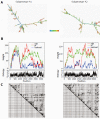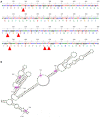Role of RNA secondary structure in emergence of compartment specific hepatitis B virus immune escape variants
- PMID: 27878103
- PMCID: PMC5105049
- DOI: 10.5501/wjv.v5.i4.161
Role of RNA secondary structure in emergence of compartment specific hepatitis B virus immune escape variants
Abstract
Aim: To investigate the role of subgenotype specific RNA secondary structure in the compartment specific selection of hepatitis B virus (HBV) immune escape mutations.
Methods: This study was based on the analysis of the specific observation of HBV subgenotype A1 in the serum/plasma, while subgenotype A2 with G145R mutation in the peripheral blood leukocytes (PBLs). Genetic variability found among the two subgenotypes was used for prediction and comparison of the full length pregenomic RNA (pgRNA) secondary structure and base pairings. RNA secondary structures were predicted for 37 °C using the Vienna RNA fold server, using default parameters. Visualization and detailed analysis was done using RNA shapes program.
Results: In this analysis, using similar algorithm and conditions, entirely different pgRNA secondary structures for subgenotype A1 and subgenotype A2 were predicted, suggesting different base pairing patterns within the two subgenotypes of genotype A, specifically, in the HBV genetic region encoding the major hydrophilic loop. We observed that for subgenotype A1 specific pgRNA, nucleotide 358U base paired with 1738A and nucleotide 587G base paired with 607C. However in sharp contrast, in subgenotype A2 specific pgRNA, nucleotide 358U was opposite to nucleotide 588G, while 587G was opposite to 359U, hence precluding correct base pairing and thereby lesser stability of the stem structure. When the nucleotides at 358U and 587G were replaced with 358C and 587A respectively (as observed specifically in the PBL associated A2 sequences), these nucleotides base paired correctly with 588G and 359U, respectively.
Conclusion: The results of this study show that compartment specific mutations are associated with HBV subgenotype specific alterations in base pairing of the pgRNA, leading to compartment specific selection and preponderance of specific HBV subgenotype with unique mutational pattern.
Keywords: Compartmentalization; G145R; Hepatitis B; Peripheral blood leukocytes; RNA secondary structure; pgRNA.
Conflict of interest statement
Conflict-of-interest statement: None of the authors have any conflict of interest to disclose.
Figures



Similar articles
-
Genetic characterization of hepatitis B virus in peripheral blood leukocytes: evidence for selection and compartmentalization of viral variants with the immune escape G145R mutation.J Virol. 2009 Oct;83(19):9983-92. doi: 10.1128/JVI.01905-08. Epub 2009 May 6. J Virol. 2009. PMID: 19420079 Free PMC article.
-
Distinctive sequence characteristics of subgenotype A1 isolates of hepatitis B virus from South Africa.J Gen Virol. 2004 May;85(Pt 5):1211-1220. doi: 10.1099/vir.0.19749-0. J Gen Virol. 2004. PMID: 15105537
-
Are hepatitis B virus "subgenotypes" defined accurately?J Clin Virol. 2010 Apr;47(4):356-60. doi: 10.1016/j.jcv.2010.01.015. Epub 2010 Feb 13. J Clin Virol. 2010. PMID: 20153973
-
Natural history of chronic hepatitis B in Euro-Mediterranean and African countries.J Hepatol. 2011 Jul;55(1):183-91. doi: 10.1016/j.jhep.2010.12.030. Epub 2011 Jan 14. J Hepatol. 2011. PMID: 21238520 Review.
-
Molecular characteristics and clinical relevance of African genotypes and subgenotypes of hepatitis B virus.S Afr Med J. 2018 Aug 8;108(8b):17-21. doi: 10.7196/SAMJ.2018.v108i8b.13495. S Afr Med J. 2018. PMID: 30182908 Review.
References
-
- Datta S, Panigrahi R, Biswas A, Chandra PK, Banerjee A, Mahapatra PK, Panda CK, Chakrabarti S, Bhattacharya SK, Biswas K, et al. Genetic characterization of hepatitis B virus in peripheral blood leukocytes: evidence for selection and compartmentalization of viral variants with the immune escape G145R mutation. J Virol. 2009;83:9983–9992. - PMC - PubMed
-
- Ramirez S, Perez-Del-Pulgar S, Carrion JA, Costa J, Gonzalez P, Massaguer A, Fondevila C, Garcia-Valdecasas JC, Navasa M, Forns X. Hepatitis C virus compartmentalization and infection recurrence after liver transplantation. Am J Transplant. 2009;9:1591–1601. - PubMed
LinkOut - more resources
Full Text Sources
Other Literature Sources

